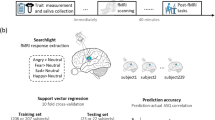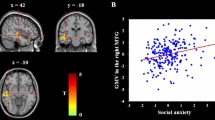Abstract
Williams-Beuren syndrome (WBS), caused by a microdeletion of approximately 21 genes on chromosome 7q11.23, is characterized by unique hypersociability combined with increased non-social anxiety. Using functional neuroimaging, we found reduced amygdala activation in individuals with WBS for threatening faces but increased activation for threatening scenes, relative to matched normal controls. Activation and interactions of prefrontal regions linked to amygdala, especially orbitofrontal cortex, were abnormal, suggesting a genetically controlled neural circuitry for regulating human social behavior.


Similar content being viewed by others
References
Adolphs, R. Nat. Rev. Neurosci. 4, 165–178 (2003).
Klein-Tasman, B.P. & Mervis, C.B. Dev. Neuropsychol. 23, 269–290 (2003).
Bellugi, U., Adolphs, R., Cassady, C. & Chiles, M. Neuroreport 10, 1653–1657 (1999).
Dykens, E.M. Dev. Neuropsychol. 23, 291–316 (2003).
Meyer-Lindenberg, A. et al. Neuron 43, 623–631 (2004).
Prather, M.D. et al. Neuroscience 106, 653–658 (2001).
Amaral, D.G. Biol. Psychiatry 51, 11–17 (2002).
Hariri, A.R., Tessitore, A., Mattay, V.S., Fera, F. & Weinberger, D.R. Neuroimage 17, 317–323 (2002).
Hariri, A.R., Mattay, V.S., Tessitore, A., Fera, F. & Weinberger, D.R. Biol. Psychiatry 53, 494–501 (2003).
Dilger, S. et al. Neurosci. Lett. 348, 29–32 (2003).
Ghashghaei, H.T. & Barbas, H. Neuroscience 115, 1261–1279 (2002).
Wood, J.N., Romero, S.G., Knutson, K.M. & Grafman, J. Neuropsychologia 43, 249–259 (2005).
Reiss, A.L. et al. J. Neurosci. 24, 5009–5015 (2004).
Kringelbach, M.L. & Rolls, E.T. Prog. Neurobiol. 72, 341–372 (2004).
Quirk, G.J., Likhtik, E., Pelletier, J.G. & Pare, D. J. Neurosci. 23, 8800–8807 (2003).
Acknowledgements
We thank N. Dixit, A. Bonner-Jackson, R. Olsen and J. Holt for research assistance; A. Goldman and Q. Chen for single-subject analyses and D. Weinberger for helpful discussion. This work was supported by the US National Institute of Mental Health intramural program and National Institute on Neurological Disorders and Stroke grant NS35102 to C.B.M.
Author information
Authors and Affiliations
Corresponding author
Ethics declarations
Competing interests
The authors declare no competing financial interests.
Supplementary information
Supplementary Fig. 1
Single-subject analyses in native space of activation during the face-matching task. (PDF 3219 kb)
Supplementary Fig. 2
Single-subject analyses in native space of activation during the scene-matching task. (PDF 3325 kb)
Supplementary Table 1
Demographics and behavioral data. (PDF 50 kb)
Supplementary Table 2
Amygdala activation in the faces and IAPS matching tasks. (PDF 40 kb)
Supplementary Table 3
Cortical activation in the faces and IAPS matching tasks. (PDF 55 kb)
Rights and permissions
About this article
Cite this article
Meyer-Lindenberg, A., Hariri, A., Munoz, K. et al. Neural correlates of genetically abnormal social cognition in Williams syndrome. Nat Neurosci 8, 991–993 (2005). https://doi.org/10.1038/nn1494
Received:
Accepted:
Published:
Issue Date:
DOI: https://doi.org/10.1038/nn1494
- Springer Nature America, Inc.
This article is cited by
-
Pain characteristics in people with Prader-Willi, Williams, and Fragile-X syndromes: an international survey of caregivers’ perspective
Journal of Developmental and Physical Disabilities (2023)
-
Heterogene neuropsychiatrische Phänotypen bei zwei erwachsenen Patient*innen mit 22q11.2-Deletionssyndrom (DiGeorge-Syndrom): ein Fall für RDoC?
Der Nervenarzt (2022)
-
Serotonergic innervation of the amygdala is increased in autism spectrum disorder and decreased in Williams syndrome
Molecular Autism (2020)
-
William’s Syndrome: Brain-Behavior Relationships and Implications for School Psychologist
Contemporary School Psychology (2020)
-
Neuronal deletion of Gtf2i, associated with Williams syndrome, causes behavioral and myelin alterations rescuable by a remyelinating drug
Nature Neuroscience (2019)





